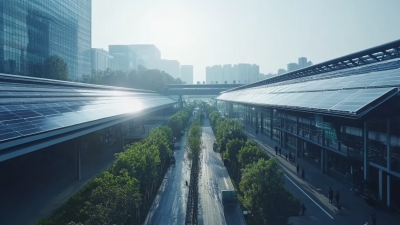Temporary & Portable Solar Lighting
What Defines the Efficiency of Industrial Solar Lights
As the demand for sustainable energy solutions continues to rise, the efficiency of Industrial Solar Lights has become a pivotal focus for businesses seeking to reduce operational costs and environmental impact. According to a report by the International Renewable Energy Agency (IRENA), solar power capacity has increased by over 20% annually since 2014, highlighting the growing reliance on renewable sources. Industrial Solar Lights not only provide illumination but also contribute to significant cost savings, with studies indicating that they can reduce energy costs by up to 70% compared to traditional lighting systems. Furthermore, advancements in photovoltaic technology and battery storage have led to improvements in the performance and longevity of these systems, making them a more viable option for industries. Understanding the factors that influence the efficiency of Industrial Solar Lights, such as solar panel quality, battery type, and installation design, is essential for maximizing their benefits and ensuring a greater return on investment.

Understanding Solar Light Technology in Industrial Settings
Understanding solar light technology in industrial settings is crucial for enhancing operational efficiency and sustainability. Industrial solar lights harness solar energy through photovoltaic cells, converting sunlight into electricity, which powers LEDs for illumination. According to the Solar Energy Industries Association (SEIA), industrial applications of solar technology have been growing at an annual rate of over 20%, reflecting an increasing recognition of their economic and environmental benefits.
When selecting solar lighting solutions, consider the overall system efficiency, which includes solar panel effectiveness, battery capacity, and LED performance. Research indicates that high-quality solar lights can achieve luminous efficacy values exceeding 100 lumens per watt, significantly improving energy consumption compared to traditional lighting. Furthermore, integrating smart technology, such as motion sensors and dimming controls, can enhance energy savings by up to 30%.
Tips: To maximize the benefits of industrial solar lighting, ensure proper installation and location orientation to capture optimal sunlight. Regular maintenance, such as cleaning the solar panels, will also improve their performance and lifespan, ensuring consistent illumination for industrial operations.

Key Factors Influencing the Efficiency of Industrial Solar Lights
The efficiency of industrial solar lights is influenced by several key factors, each playing a pivotal role in optimizing their performance. One significant aspect is solar irradiance, which measures the power of solar energy received per unit area. Variations in solar irradiance directly affect the energy conversion efficiency of solar panels. Therefore, selecting the right location with an optimal amount of sunlight is crucial for industrial solar implementations.
Ambient temperature and atmospheric conditions also considerably impact the efficiency of solar lights. Higher temperatures can lead to increased resistance within solar cells, while varying weather patterns can influence light availability. Additionally, advancements in technology, such as the integration of innovative coatings like monolayer nano-TiO2, can provide protection against UV degradation and moisture. These developments not only enhance durability but also ensure that solar systems maintain high performance over time, balancing the challenges posed by environmental factors.
Lastly, terrain effects play a significant role in determining the efficiency of solar energy systems. Uneven landscapes can lead to shading, reducing the overall sunlight exposure of solar panels. Understanding these environmental influences is vital for the successful deployment and operation of industrial solar lights, as maximizing efficiency requires a holistic approach that takes all these factors into account.
Comparative Analysis: Solar Lights vs Traditional Lighting Solutions
In the realm of industrial lighting, the comparative analysis of solar lights versus traditional lighting solutions reveals substantial differences in efficiency, sustainability, and cost-effectiveness. Traditional lighting systems, primarily reliant on grid electricity, incur ongoing operational costs and contribute significantly to carbon emissions. In contrast, solar lights harness renewable energy from the sun, providing a self-sufficient lighting solution that minimizes both energy expenses and environmental impact. This shift not only reduces reliance on fossil fuels but also positions solar lights as a pivotal player in the transition toward greener practices within industrial operations.
Furthermore, the efficiency of solar lights is enhanced by advancements in technology, such as improved solar panels and energy storage systems. These innovations allow for better energy conversion and longer-lasting lighting periods, outperforming many conventional systems that require frequent maintenance and bulb replacements. While traditional lighting may initially appear more familiar and widely applicable, the long-term benefits of solar lights—characterized by lower energy costs, reduced environmental impact, and the potential for energy independence—signal a shift in how industries might approach their lighting needs in the future.

Best Practices for Maximizing Performance of Industrial Solar Lighting
Maximizing the performance of industrial solar lighting can significantly enhance overall energy efficiency while minimizing operational costs. One of the key best practices involves integrating advanced energy-efficient materials and methodologies. For instance, studies highlight that utilizing innovative designs supported by daylighting technology can help achieve nearly zero-energy buildings, a growing trend in sustainable design. Implementing these technologies not only reduces energy demands but also transforms how industrial spaces leverage natural resources.
Tips for enhancing solar lighting performance include regular maintenance and cleaning of photovoltaic systems. Research indicates that the impact of dust and debris can significantly diminish solar panels' efficiency, leading to reduced energy output. Establishing a routine cleaning schedule and employing optimal cleaning techniques tailored to specific environmental conditions can enhance yield and ensure long-term performance.
Moreover, utilizing bifacial tracking systems is another effective strategy. These systems enable photovoltaic panels to capture sunlight from both sides, increasing energy generation potential. As the solar energy industry continues to innovate, embracing these advanced solutions is vital for maximizing the efficiency of industrial solar lights, allowing facilities to harness the full potential of renewable energy sources.
Efficiency of Industrial Solar Lights
Future Trends in Industrial Solar Lighting Technology and Efficiency
As we look towards the future of industrial solar lighting technology, several trends are defining its efficiency and adoption within the global market. The increasing emphasis on sustainable solutions, particularly in light of climate change commitments, drives innovation in solar lighting systems. Future trends suggest a growing integration of smart technologies that enhance energy management, allowing industrial users to optimize their energy consumption and reduce operational costs. This intelligent approach not only improves efficiency but also aligns with the broader goals of carbon neutrality and low-carbon technologies.
Tips: When considering the implementation of industrial solar lights, it's essential to evaluate the specific lighting needs of your facility. Assess the local climate conditions and potential obstacles that may affect solar exposure. Additionally, investing in programmable lighting systems can provide flexibility, adapting energy use according to operational demands.
Another notable trend is the advancement in solar panel technology, particularly the rise of perovskite solar cells. These innovations promise to increase the energy conversion efficiency of solar panels, making industrial solar lighting systems more viable than ever. As we continue to embrace these technologies, they will play a critical role in transforming the landscape of industrial lighting, paving the way for a cleaner and more efficient future.
Tips: Always monitor the market for the latest advancements in solar technology, as these can significantly impact the long-term return on investment for your lighting solutions. Consider partnering with suppliers who prioritize cutting-edge technology to ensure you remain at the forefront of the industry.
What Defines the Efficiency of Industrial Solar Lights - Future Trends in Industrial Solar Lighting Technology and Efficiency
| Technology Type | Light Output (Lumens) | Solar Panel Efficiency (%) | Battery Life (Hours) | Charging Time (Hours) | Installation Cost ($) | Expected Lifespan (Years) |
|---|---|---|---|---|---|---|
| LED Solar Light | 1000 | 20 | 12 | 6 | 250 | 10 |
| Solar Flood Light | 2000 | 25 | 24 | 8 | 500 | 15 |
| Solar Street Light | 1500 | 22 | 10 | 5 | 400 | 12 |
| Solar Garden Light | 500 | 18 | 8 | 4 | 100 | 8 |
Related Posts
-

Discover the Advantages of Solar Powered Parking Lot Lights for Sustainable Energy Solutions
-

Exploring the Growth of Exterior Solar Lights at the 137th Canton Fair in Guangzhou
-

The Ultimate Guide to Choosing the Best Solar Hanging Lights for Global Buyers
-

5 Reasons Why Best Solar Parking Lot Lights Are Revolutionizing Outdoor Lighting in 2023
-

2025 Market Trends for Best Garden Solar Lights and Essential Tips for Homeowners
-

Choosing Quality Manufacturers for Best Outdoor Solar Lights to Illuminate Your Home
USA / Americas
1507 Capital Ave, Suite 102
Plano, TX 75074
+1 (214) 838-7010
8:00am – 5:00pm (GMT-6)
Australia / Asia Pacific
503 Cross Keys Rd,
Cavan SA 5094
+61 8 7200 3909
9:00am – 5:00pm (ACDST)
© 2025 Green Frog Systems. | Privacy Policy | Terms & Conditions


